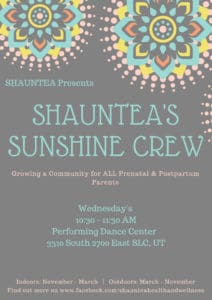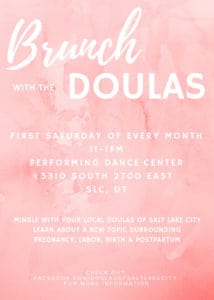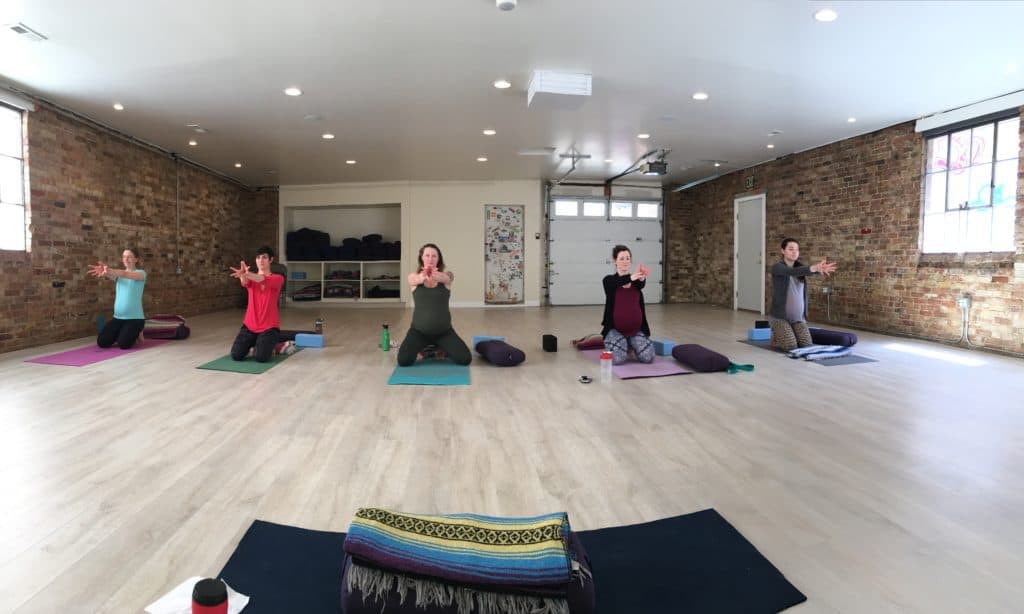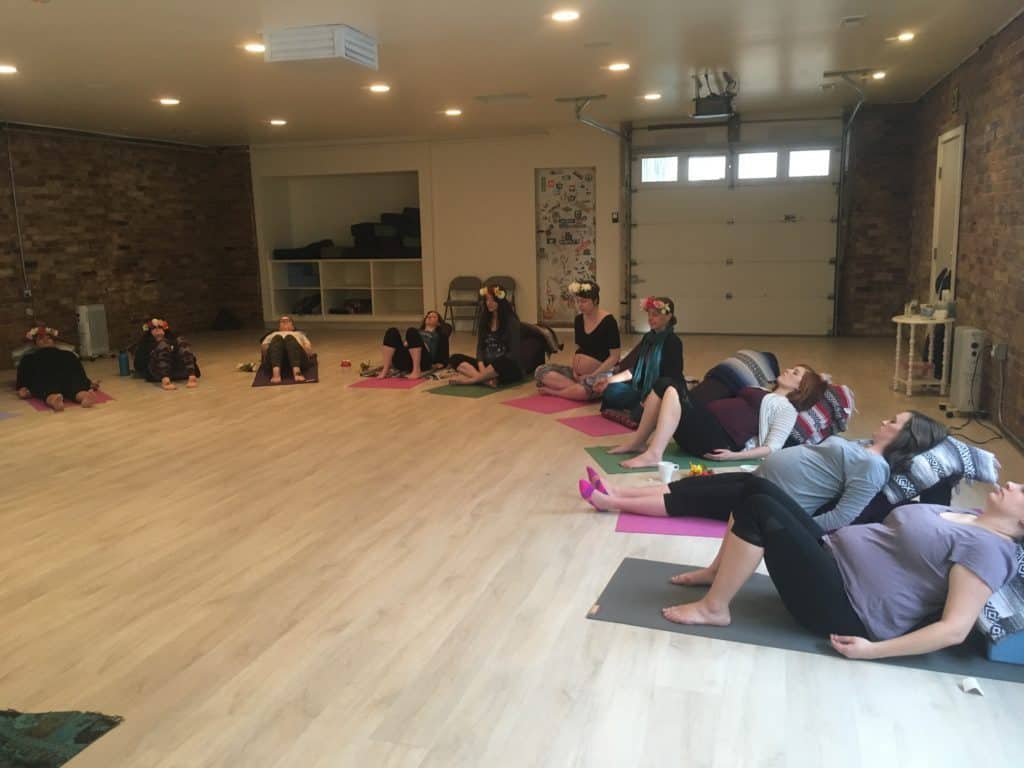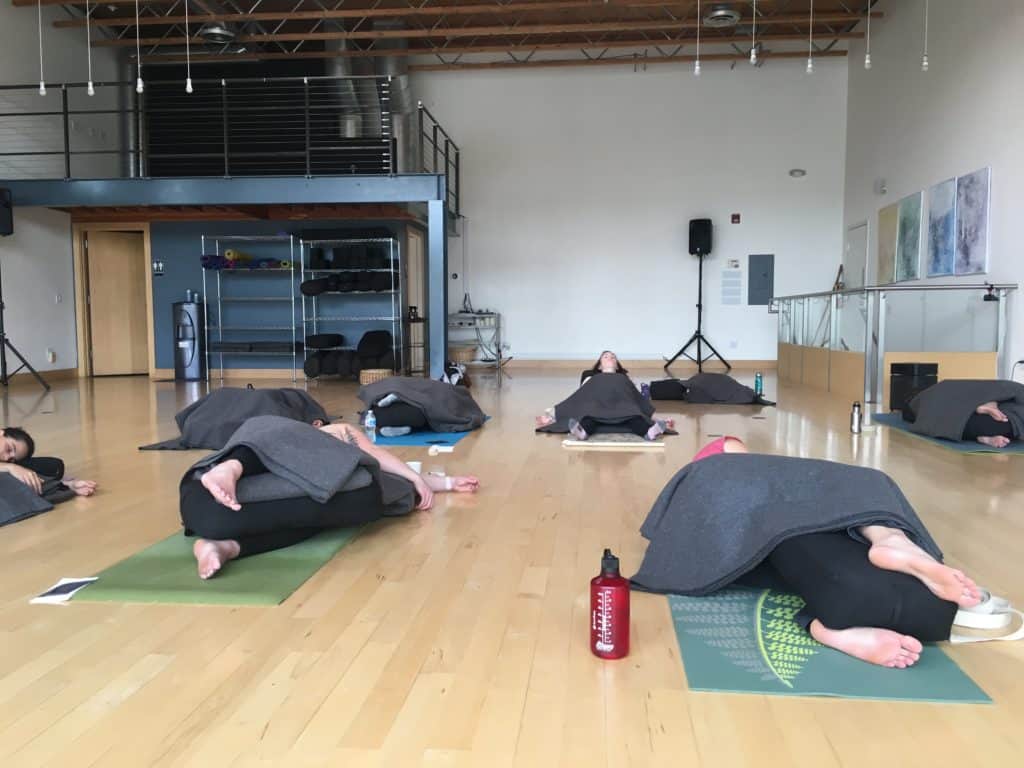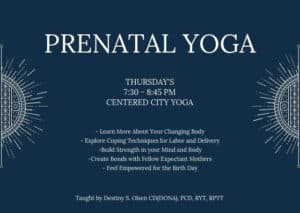Benefits of Prenatal and Postpartum Yoga
By: Destiny S. Olsen BD(DONA), PCD(DONA), RYT, TPYT
The sanskrit word yoga translates to yolk or union. The path of yoga is a path of union, union of breathe to the body, union of the mind to the muscles, union of the body, mind, spirit and ultimately, union of creation.
For those of you starting to think about having a baby, those who are pregnant or just had their little one—this practice of yoga can be quite profound and powerful during this time.
We are currently in a time when “ everyone is doing it.” Perception of yogis are no longer tied into funny outfits, hippies, religious freaks or people who sit in weird position for long periods of time. Silicon Valley business owners, musicians, artists, educators, garbage men, construction workers, students and mothers, to name a few, are all approaching yoga with the new idea of yoga being a part of a new health revolution—a revolution that physical exercise then leads to mental strength and longevity and vise versa.
We are seeing widespread behavioral changes through professional and educational settings that implement yoga—impacting bullying, relationships, coping skills, and even productivity.
We are cultivating through yoga nicer, happier people that aren’t being “yanked” around by their feelings or emotional insecurities because they are more aware and have the skills to manage when they get thrown off kilter.
Through yogic practices you can create a internal telescope where you are able to decipher how you feel, why you feel that way, and access the tools you have to alter or enhance these feelings.
So where did yoga come from? Yoga is a science of complete self realization that was channeled, intuited, and practiced by people who dedicated their lives to dissolving borders and boundaries within themselves. They then codified these practices into a system that could be understood, imbedded and applied by people from every walk of life. One of these systems developed is called the 8 fold path.
This 8 fold path is neither linear or circular—rather an ebb and flow between one or many of them all at the same time. They are,
Yama: Self of integrity or ethical standards within yourself and others
- Non violence “I value all things and all people the same as myself”
- Non harm “Do no harm to myself or others whether it be thought or action”
- Truthfulness “I am trustworthy in my dealings with myself and others”
- Honesty “I am honest with myself and others”
- Non coveting “I have everything I need”
- Self honoring “I value myself and others through holding acceptable boundaries”
Niyama: Practices that relate to our inner world
- Cleanliness “I take care of my body through healthy food and habits”
- Contentment “I am exactly where I need to be”
- Self Discipline “I can have discipline to accomplish my goals”
- Study of Oneself “I can self reflect on myself and my purpose”
- Surrender “This karmic path will lead me where I need to go, I release control”
Asana: translated as postures. This is the fundamental face of yoga and for some lineages the medium through which the union takes place. However asanas only become yoga if it then leads to a spiritual union—not just flexibility and strength. Through the practice of postures we develop the habit of self discipline, self reflection and the ability to concentrate.
Pranayama: translated as breathe control, expansion. This limb is to not only gain control over our respiratory systems but to create a connection between breath, mind and emotion. Knowing how to master your breathe and using it to your benefit can only improve your experience through everyday life. This practice of breathe can aide with: control over emotional health and wellbeing, release of emotion and muscular tension creating more ease, better sleep, digestion and blood circulation. This is also a recurring focus through labor and birth “breathing your baby down”.
Pratyahara: translated as sensory transcendence. This is where we shift off the external world and stimuli-directing our attention internally. This practice is to take a step back to look at ourselves, learning how to become observant. As you become a parent less and less time is navigated to self reflection. Put down the distractions (i.e. phones, computers, tv) to tune into what truly matters to you.
Dharana (der-yana): concentration of the mind, aka meditation. This component of yoga is to focus your mind on one point regardless of internal or external focus. This act of driven concentration is to slow down our process of thinking as a whole.
Examples:Drishti points, birthing alters, are external. Drawing eyes upward and closed, envisioning baby in belly is internal.
Dayana(die-yana): Uninterrupted flow of concentration. Instead of having to focus you are now, just aware. Your mind quieted and complete stillness sets in. You move through life moment to moment.
Samadhi: This is ultimate peace. You connect to all living thing and transcend. This isn’t something that can be bought, rather practiced and earned.
So why and how is yoga useful during pregnancy? You’re changing a lot on many facets during this time, including these ways listed below:
Anatomical/Body Changes:
- Blood Pressure Alterations
- Internal Organ Displacement
- Increase of Mucus Production
- Increase Blood Volume
- Weight Gain and Distribution throughout your Body
Emotional/Mental Changes:
- Hormonal Changes
- Social Responsibilities of Being a Parent
- “Pregnancy Brain”
Research performed by the Mayo Clinic suggest that yoga is safe and has many benefits to moms and their babies such as:
- Improves Sleep
- Reduces Stress and Anxiety
- Increases Strength, Flexibility, and Endurance for muscles that are needed for childbirth
- Decreases: lower back pain, nausea, body discomfort, carpal tunnel syndrome, headaches and shortness of breath
- Decreases the risk of: preterm labor, pregnancy induced hypertension and intrauterine restriction
- Creates a community by bonding with other pregnant moms
- Prepares you for other life changes of becoming a new parent or adding a family member
Gained skills for the Postpartum Period and Child Raising Years:
- Creates a more mindful existence in your body, mind and soul
- Aides in gaining tools for stress management
- Builds a better sense of self-identity and personal power
- Develops better habits for self discipline and concentration
- In depth coping skills
- Deeper bond between baby, partner, family and friends
This information is intended for a paying client or student. Please do not copy, share or distribute unless given approval and permission by SHAUNTEA, LLC.
About Destiny:

Destiny is currently taking on birth doula clients for the 2019 year. Check out her social media pages and the fliers below for more opportunities to learn more about yourself, your changing body and parenthood.
Phone: 801-361-9785
Email: shaunteahealthandwellness@gmail.com
Website: www.shaunteahealthandwellness.com
Facebook: facebook.com/shaunteahealthandwellness
Instagram: @shaunteahealthandwellness, @destinysolsen
